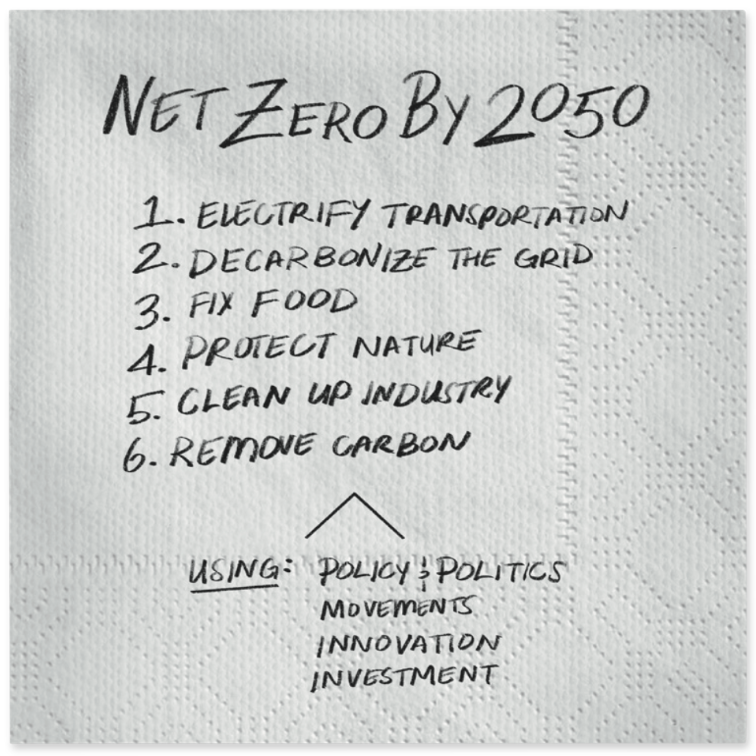Our aim is to reach net-zero carbon emissions by 2050—and get halfway there by 2030.
The Speed & Scale plan is a pathway toward achieving that ambitious goal. For example, we can cut six billion tons of greenhouse gasses—10 percent of the annual global total—by electrifying transportation. To reach this objective, we’ll need specific actions: replacing diesel buses with electric ones, installing hundreds of thousands of vehicle charging stations, and more.
In confronting this enormous challenge, we must be strategic. What should we do first? What will have the biggest difference? Here’s our shortlist of high-impact actions you can take in 2024.
What Can You Do?
As an individual you can:
Switch to an electric vehicle:
If you can’t afford one right now, commit to making the vehicle you drive today the last fossil fuel vehicle you will own or lease. (On average, gasoline accounts for 25 percent of a household’s carbon footprint.)
Power your home with clean energy:
Sign up for a clean(er) energy plan from your utility. Or add solar panels and a battery to reduce your reliance on the local grid (and, by extension, on fossil fuels). Replace your gas appliances with electric heat pumps and an electric or induction stove. Install a smart thermostat and insulate your home. (On average, electricity and heating account for 14 percent of a household’s carbon footprint.)
Eat less beef and waste less food:
Consume lower-emissions proteins such as pork, chicken, or fish, or one of the many new plant-based proteins. Throw out less food, and compost what you don’t eat. (On average, food accounts for 19 percent of a household’s carbon footprint, with nearly half of that from dairy and meat.)
On their own, there are limits to what any individual can accomplish in this arena. How can you increase your impact? To make your voice heard on the important climate policy decisions of the day, join a climate advocacy organization such as The Climate Reality Project, 350.org, or one of the many global Climate Action Network members.
What Can Your Company or Organization Do?
As an executive or manager, you can:
Procure clean energy:
Convert your office, factory, store, or restaurant to carbon-free electricity. Call your utility to identify your options. Deploy solar and batteries onsite. To reduce fossil fuel consumption, replace gas appliances with electric heat pumps, boilers, and stoves. If your company owns your building, you can take these initiatives yourself; if not, reach out to the owner.
Decarbonize your transport of people and goods:
For companies with their own vehicle fleets, now is the time to plan to electrify them. Set a progressive, year-by-year procurement target to get you to 100 percent electricity-powered cars by 2030 and electricity-powered trucks by 2035. Regardless of where we stand with the pandemic, don’t rush back to sending people on business flights. Capitalize on the efficiencies and flexibility of virtual meetings. Set a higher bar for stepping on a plane.
Shrink the carbon footprint of the goods you manufacture:
You can’t manage what you don’t measure. Start by tracking and cutting emissions for anything you produce. A few practical options: Seek out new suppliers. Use cleaner heat sources in your production processes. Move to climate-friendly materials and packaging. Label your goods with clear recycling and composting instructions.
Purchase high-quality carbon removal:
As described in Speed & Scale, your first priority is to cut your emissions by finding cleaner alternatives. Your next challenge is to conserve energy with greater efficiency. Finally, you need to remove and sequester your remaining CO2 emissions from the atmosphere–either through nature-based options like reforestation or engineered removal options like Climeworks or Charm Industrial.
As an employee, you can advocate for any or all of these actions. In concert with like-minded co-workers, make the case that these planet-friendly changes will strengthen the company’s brand, boost employee morale, and build a climate-conscious customer base.
What Can Your City Do?
As an elected or government official, you can:
Work with your electric utility to cut emissions by 90 percent by 2035:
Since cities are often their local utilities’ partners and largest customers, see to it that new investments in the power grid are channeled toward carbon-free energy sources. Create a plan that cuts greenhouse gas emissions in half by 2025 and by 90 percent by 2035.
Update building codes to end the use of natural gas and consume less energy:
Following the lead of New York City and Denver, tighten rules to prohibit natural gas in new construction. Alternatives: for heating and cooling, energy-saving electric heat pumps; for water heaters, electric boilers. For climate-friendly cooking, look to induction stoves. When gas-powered appliances break, codes should mandate their replacement with electric equivalents.
Build out a citywide network of protected bike lanes:
This offers the highest return on investment of infrastructure dollars for easing and speeding commutes, reducing congestion, and cutting a city’s emissions. By making cycling safer, protected lanes will broaden its adoption.
The emissions profile for each city will vary based on its geography and urban layout. By checking your city’s greenhouse gas inventory, you’ll see the potential local impact of these three actions for cutting greenhouse gas emissions. For example, according to New York City’s published annual inventory, 36 percent of emissions come from natural gas, 29 percent from electricity generation, and 24 percent from transportation. By comparison, Denver generates 35 percent of its emissions from electricity generation, 20 percent from transportation, and 14 percent from natural gas. Los Angeles has a very different emissions profile, with transportation accounting for 62 percent of its emissions.
Your State or Provincial Government
As an elected or government official, you can:
Finance large energy projects:
To stay on pace to cut emissions in half by 2025 and by 90 percent by 2035, pass legislation and finance grid improvements, electricity storage, and new solar, wind, and geothermal energy projects. Since demand for electricity will keep rising as we’re cleaning our grids, utilities cannot do this alone.
Unblock and then accelerate electrification:
Red tape is slowing the deployment of solar, battery, and charging projects that need to be built today. Pass statewide policy to address permitting issues. Incentivize consumer purchases of EVs and adoption of solar, and electrified mass transit and school buses. Deploy charging infrastructure.
Require private planes to use sustainable jet fuel:
There is no existing market for sustainably produced jet fuel, which would cut aviation emissions up to 80 percent. At present, the technology is new and the volume of production is low, making the fuel too expensive for commercial air travel without regulation. But action on the state level can begin to shift that equation. To lower the price and increase availability, states can require private planes to use a sustainable aviation fuel (SAF) blend for trips to and from its airports.
What Can Your Federal Government Do?
As an elected or government official, you can:
Pay for innovation:
Governments are in a unique position to catalyze research, development, and deployment of clean energy. The U.S. needs to increase its grants and loans for energy R&D by 5x; other countries should aim to triple their R&D funding. Even more directly, governments are significant purchasers of energy, heating and cooling, and vehicles. It can use its procurement power to purchase the cleaner, greener alternative.
End deforestation and accelerate reforestation:
Pass laws to end human-caused deforestation by 2025, which is five years ahead of the target set at COP26.
Tax methane and other carbon pollution:
Charge oil and gas companies for flaring, venting, and leaks. (Or simply prohibit it using regulations.) Signal to the market that a carbon tax on industry is coming, in part to keep the U.S. competitive with the European Union.
Use market and efficiency standards to accelerate the phaseout of fossil fuels
Set standards that phase out fossil fuels for motor vehicles, appliances, and other energy-intensive products. Example: a program that sets efficiency targets based on the best-performing available product.
As a voter, you can contact your elected representative and share how important these actions are to you. Attend public meetings where these topics are discussed and make your voice heard. If your officials fail to take action, mobilize and register people to vote for new officials who will. Organize or support ballot propositions. Join an organization working to enact climate solutions.
Companies can also be powerful advocates for a net zero future. The clean energy transition is a tremendous economic opportunity. To create jobs and lead in the new clean energy economy, companies can demand action from city, state, and federal governments.












